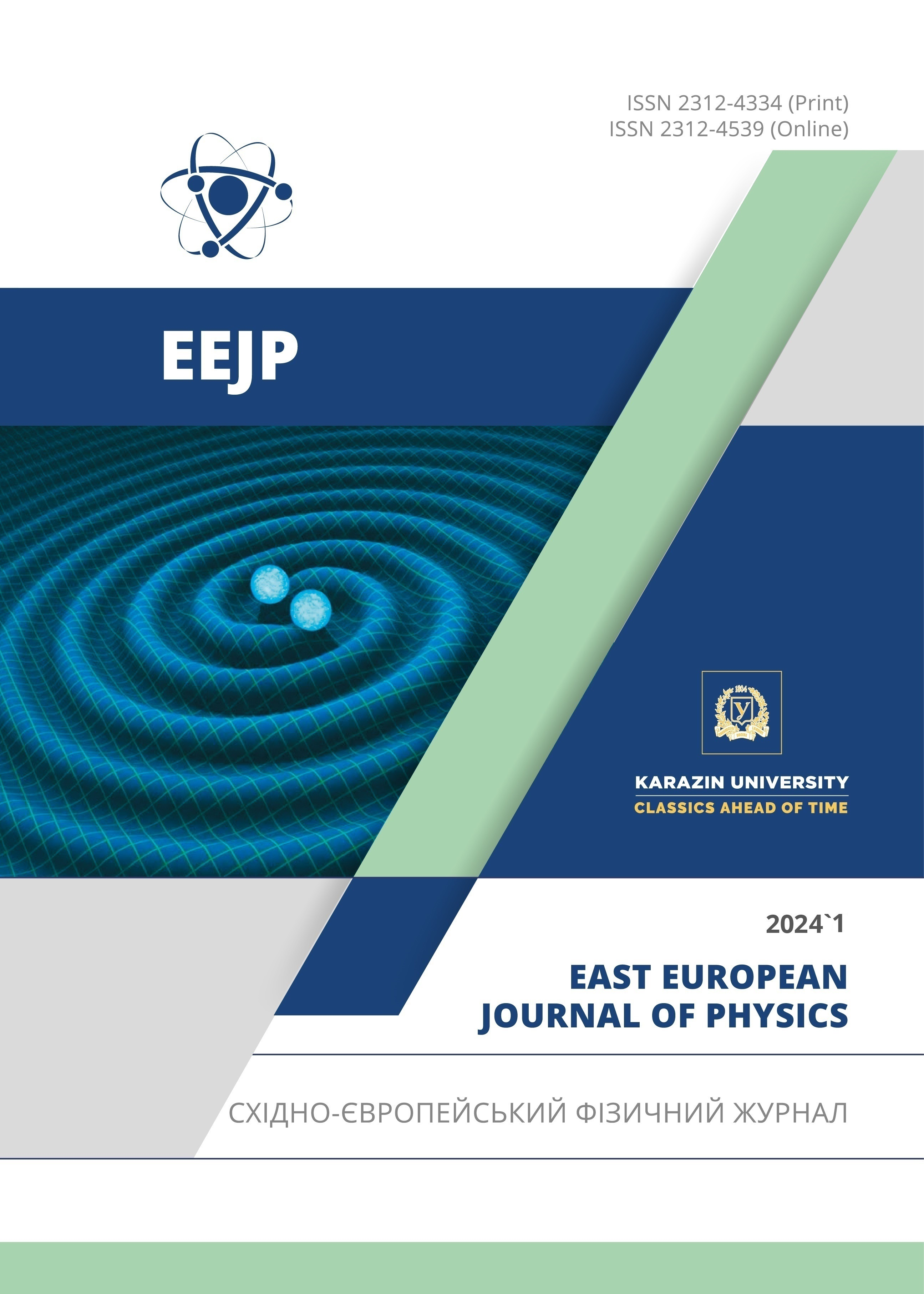Comparative EPR Analysis of Modern and Fossil Tooth Enamel: Unveiling Aging-Induced Components
Abstract
This study involves comparing EPR signals from three-year-old modern cow tooth enamel with the spectra of fossil tooth enamel exposed to natural background radiation over an extended period. The EPR spectrum of the significantly aged fossil tooth enamel displays additional components absent in the EPR spectra of the modern tooth enamel. Specifically, the septet signal associated with isopropyl (or alanine) radicals is not observed in the EPR signals of modern tooth enamel when irradiated up to 1.3 kGy. It is hypothesized that the isopropyl radicals present in fossil tooth enamel are not a result of radiation but rather stem from the natural breakdown of organic components due to the aging process. This characteristic is proposed as a dependable tool for authenticating tooth samples.
Downloads
References
A. Kinoshita, et al., “ESR dating of teeth from northeastern Brazilian megafauna,” Radiat. Meas. 43(2-6), 809–812 (2008). https://doi.org/10.1016/j.radmeas.2007.11.075
A. Ivannikov, V. G. Skvortsov, V.F. Stepanenko, and K.S. Zhumadilov, “Comparative analysis between radiation doses obtained by EPR dosimetry using tooth enamel and established analytical methods for the population of radioactively contaminated territories,” Radiat. Prot. Dosimetry, 159(104), 125–129 (2014). https://doi.org/10.1093/rpd/ncu132
S. Mammadov, G.R.Z. Dadashov, and A. Ahadov, “Electron Spin Resonance Dating of Tooth Enamel,” Int. J. Res. Stud. Sci. Eng. Technol. 4(7), 1–3 (2017). https://doi.org/10.5281/zenodo.8134294
R. Joannes-Boyau, and R. Grün, “A comprehensive model for CO2- radicals in fossil tooth enamel: Implications for ESR dating,” Quat. Geochronol. 6(1), 82–97 (2011). https://doi.org/10.1016/j.quageo.2010.09.001
D. Richter, et al., “The age of the hominin fossils from Jebel Irhoud, Morocco, and the origins of the Middle Stone Age,” Nature, 546(7657), 293–296 (2017). https://doi.org/10.1038/nature22335
M. Duval, and R. Grün, “Are published ESR dose assessments on fossil tooth enamel reliable?,” Quat. Geochronol. 31, 19–27 (2016). https://doi.org/10.1016/j.quageo.2015.09.007
R. Joannes-Boyau, “Detailed protocol for an accurate non-destructive direct dating of tooth enamel fragment using Electron Spin Resonance,” Geochronometria, 40(4), 322–333 (2013). https://doi.org/10.2478/s13386-013-0132-7
R. Grün, M. Aubert, J. Hellstrom, and M. Duval, “The challenge of direct dating old human fossils,” Quat. Int. 223–224, 87 93 (2010). https://doi.org/10.1016/j.quaint.2009.10.005
R. Grün, and C. Stringer, “Direct dating of human fossils and the ever-changing story of human evolution,” Quat. Sci. Rev. 322, 108379 (2023). https://doi.org/10.1016/j.quascirev.2023.108379
E.A. Ainsbury, et al., “Review of retrospective dosimetry techniques for external ionising radiation exposures,” Radiat. Prot. Dosimetry, 147(4), 573–592 (2011). https://doi.org/10.1093/rpd/ncq499
G. Vanhaelewyn, F. Callens, and R. Grün, “EPR spectrum deconvolution and dose assessment of fossil tooth enamel using maximum likelihood common factor analysis,” Appl. Radiat. Isot. 52, 1317–1326 (2000). https://doi.org/10.1016/S0969-8043(00)00090-7
P. Fattibene, D. Aragno, S. Onori, and M. C. Pressello, “Thermal induced EPR signals in tooth enamel,” Radiat. Meas. 32(5), 793–798 (2000). https://doi.org/10.1016/S1350-4487(00)00068-8
M. Ikeya, “Paramagnetic Alanine Molecular Radicals in Fossil Shells and bones,” Naturwissenschaften, 68, 474–475 (1981).
M. Duval, “Electron Spin Resonance (ESR) Dating of Fossil Tooth Enamel,” in: Encyclopedia of Scientific Dating Methods, edited by W. Jack Rink, and J. Thompson, (Springer Dordrecht, 2015). https://doi.org/10.1007/978-94-007-6326-5
J.E. Aldrich, B. Pass, and C. Mailer, “Changes in the paramagnetic centres in irradiated and heated dental enamel studied using electron paramagnetic resonance,” Int. J. Radiat. Biol. 61(3), 433–437 (1992). https://doi.org/10.1080/09553009214551131
O.I. Scherbina, and A. B. Brik, “Temperature stability of carbonate groups in tooth enamel,” Appl. Radiat. Isot. 52(5), 1071 1075 (2000). https://doi.org/10.1016/S0969-8043(00)00048-8
S. Toyoda, et al., “Gamma-ray dose response of ESR signals in tooth enamel of cows and mice in comparison with human teeth,” Radiat. Meas. 37(4-5), 341–346 (2003). https://doi.org/10.1016/S1350-4487(03)00059-3
A. Roufosse, L.J. Richelle, and O.R. Gilliam, “Electron spin resonance of organic free radicals in dental enamel and other calcified tissues,” Arch. Oral Biol. 21(4), 227–232 (1976). https://doi.org/10.1016/0003-9969(76)90039-X
A.M. Rossi, and G. Poupeau, “Radiation Damage in Bioapatites : The ESR Spectrum of Irradiated Dental Enamel Visited,” Nuclear Tracks and Radiation Measurements, 17(4), 537–545 (1990). https://doi.org/10.1016/1359-0189(90)90014-O
M. Ikeya, New applications of electron spin resonance: Dating, Dosimetry and Microscopy, (World Scientific Publishing Co. Pte. Ltd. Singapore, 1993). pp. 500. https://doi.org/10.1016/B978-0-7234-5558-5.00006-3
M. Ikeya, “Chapter 6. Biocarbonates (Fossils),” in: New Applications of Electron Spin Resonance, 2008, pp. 87–105. https://doi.org/10.1016/B978-0-7234-5558-5.00006-3
M. Ikeya, “Chapter 2. Introduction to ESR,” in: New Applications of Electron Paramegnetic Resonace, 2008, p. 44. https://doi.org/10.21832/9781873150887-003
G.J. Hennig, and R. Grün, “ESR dating in quaternary geology,” Quat. Sci. Rev. 2(2-3), 157–238 (1983). https://doi.org/10.1016/0277-3791(83)90006-9
I.P. Vorona, S.S. Ishchenko, and N.P. Baran, “The effect of thermal treatment on radiation-induced EPR signals in tooth enamel,” Radiat. Meas. 39(2), 137-141 (2005). https://doi.org/10.1016/j.radmeas.2004.03.020
Copyright (c) 2024 Sahib Mammadov

This work is licensed under a Creative Commons Attribution 4.0 International License.
Authors who publish with this journal agree to the following terms:
- Authors retain copyright and grant the journal right of first publication with the work simultaneously licensed under a Creative Commons Attribution License that allows others to share the work with an acknowledgment of the work's authorship and initial publication in this journal.
- Authors are able to enter into separate, additional contractual arrangements for the non-exclusive distribution of the journal's published version of the work (e.g., post it to an institutional repository or publish it in a book), with an acknowledgment of its initial publication in this journal.
- Authors are permitted and encouraged to post their work online (e.g., in institutional repositories or on their website) prior to and during the submission process, as it can lead to productive exchanges, as well as earlier and greater citation of published work (See The Effect of Open Access).








